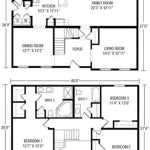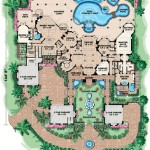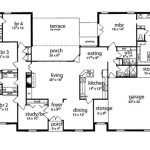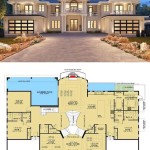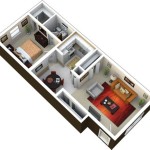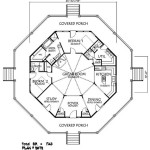A House Plan Balcony is a raised, covered or semi-covered area that projects from the facade of a building, typically supported by columns or beams. It is an extension of a house that extends outward from the building facade on one or more sides. It provides a place to relax, enjoy the outdoors, or entertain guests while remaining connected to the interior of the home.
Balconies are often used as a place to relax and enjoy the outdoors. They can be furnished with chairs, tables, and other furniture to create a comfortable and inviting space. Balconies can also be used for entertaining guests. They provide a great place to host parties or barbecues. Balconies can also be used for gardening. They can be planted with flowers, vegetables, or herbs.
In the following sections, we will explore the various design considerations for house plan balconies, including size, shape, materials, and railing options. We will also provide tips on how to choose the right balcony for your home and how to make the most of this outdoor space.
When designing a house plan balcony, there are several important points to consider, including:
- Size
- Shape
- Materials
- Railing options
- Location
- Privacy
- Sun exposure
- Drainage
- Cost
By carefully considering all of these factors, you can create a balcony that is both beautiful and functional.
Size
The size of your balcony will depend on a number of factors, including the size of your home, the amount of space you have available, and how you plan to use the balcony.
- Small balconies are typically 40 to 60 square feet in size. They are ideal for small homes or apartments, and can be used for relaxing, reading, or enjoying a cup of coffee.
- Medium balconies are typically 60 to 100 square feet in size. They are large enough to accommodate a small table and chairs, and can be used for entertaining guests or grilling out.
- Large balconies are typically over 100 square feet in size. They can be used for a variety of purposes, such as gardening, sunbathing, or hosting parties.
- Oversized balconies are typically over 200 square feet in size. They are ideal for large homes, and can be used for a variety of purposes, such as creating an outdoor living room or entertaining large groups of guests.
When choosing the size of your balcony, it is important to consider how you plan to use it. If you plan to use it for relaxing or reading, a small balcony may be sufficient. However, if you plan to use it for entertaining or grilling, you will need a larger balcony.
Shape
The shape of your balcony will depend on the style of your home and the amount of space you have available. There are a variety of different shapes to choose from, including:
- Rectangular balconies are the most common type of balcony. They are easy to build and can be used for a variety of purposes.
- Square balconies are similar to rectangular balconies, but they are wider than they are long. They are ideal for small homes or apartments.
- L-shaped balconies are a good option for homes with limited space. They can be used to create a cozy and private outdoor space.
- U-shaped balconies are similar to L-shaped balconies, but they wrap around three sides of the building. They are ideal for large homes and can be used to create a luxurious outdoor living space.
- Irregular-shaped balconies are a great option for homes with unique architectural features. They can be used to create a one-of-a-kind outdoor space.
When choosing the shape of your balcony, it is important to consider the style of your home and the amount of space you have available. You should also consider how you plan to use the balcony. If you plan to use it for relaxing or reading, a small rectangular balcony may be sufficient. However, if you plan to use it for entertaining or grilling, you will need a larger balcony with a more open shape.
Materials
The materials you choose for your balcony will depend on a number of factors, including the climate you live in, the style of your home, and your budget.
- Wood is a popular choice for balconies because it is durable, affordable, and easy to work with. However, wood balconies require regular maintenance to protect them from the elements.
- Concrete is another popular choice for balconies because it is strong, durable, and fire-resistant. However, concrete balconies can be expensive to build and may require additional support.
- Metal is a good choice for balconies because it is strong, durable, and low-maintenance. However, metal balconies can be expensive to build and may be hot to the touch in direct sunlight.
- Glass is a good choice for balconies because it is strong, durable, and offers clear views. However, glass balconies can be expensive to build and may require additional support.
When choosing the materials for your balcony, it is important to consider the climate you live in, the style of your home, and your budget. You should also consider how you plan to use the balcony. If you plan to use it for relaxing or reading, a wood or concrete balcony may be sufficient. However, if you plan to use it for entertaining or grilling, you may want to choose a metal or glass balcony.
Railing options
The railing options you choose for your balcony will depend on a number of factors, including the style of your home, the height of the balcony, and the local building codes. There are a variety of different railing options to choose from, including:
Metal railings are a popular choice for balconies because they are strong, durable, and low-maintenance. Metal railings can be made from a variety of different materials, including aluminum, steel, and wrought iron. Aluminum railings are lightweight and rust-resistant, making them a good choice for coastal areas. Steel railings are strong and durable, but they require regular maintenance to prevent rust. Wrought iron railings are strong and decorative, but they are also more expensive than other types of metal railings.
Wood railings are another popular choice for balconies. Wood railings are warm and inviting, and they can be stained or painted to match the style of your home. However, wood railings require regular maintenance to protect them from the elements.
Glass railings are a good choice for balconies because they offer clear views. Glass railings can be made from tempered glass or laminated glass. Tempered glass is strong and durable, but it can be more expensive than laminated glass. Laminated glass is made from two pieces of glass that are bonded together with a layer of plastic. Laminated glass is stronger than tempered glass, and it is also less likely to shatter if it is broken.
When choosing the railing options for your balcony, it is important to consider the style of your home, the height of the balcony, and the local building codes. You should also consider how you plan to use the balcony. If you plan to use it for relaxing or reading, a simple railing may be sufficient. However, if you plan to use it for entertaining or grilling, you may want to choose a railing that is more durable and offers more privacy.
Location
The location of your balcony will depend on a number of factors, including the orientation of your home, the views you want to enjoy, and the amount of privacy you desire.
If you want your balcony to receive morning sun, choose a balcony that faces east. If you want your balcony to receive afternoon sun, choose a balcony that faces west. If you want your balcony to be shaded from the sun, choose a balcony that faces north or south.
If you want your balcony to have views of the surrounding area, choose a balcony that is located on a higher floor. If you want your balcony to be more private, choose a balcony that is located on a lower floor or that is surrounded by trees or other buildings.
When choosing the location of your balcony, it is also important to consider the access to the balcony. You will want to choose a location that is easy to get to from the inside of your home. You should also consider the amount of traffic that will be passing by your balcony. If you want your balcony to be a private oasis, choose a location that is not visible from the street or from neighboring properties.
Once you have considered all of these factors, you can choose the perfect location for your balcony. Your balcony should be a place where you can relax and enjoy the outdoors, so take your time and choose a location that meets your needs.
Privacy
Privacy is an important consideration for many homeowners when choosing the location and design of their balcony. There are a number of ways to create a more private balcony, including:
Choose a balcony that is not visible from the street or from neighboring properties. If you want your balcony to be a private oasis, choose a location that is not visible from the street or from neighboring properties. This may mean choosing a balcony that is located on a higher floor or that is surrounded by trees or other buildings.
Install privacy screens or curtains. Privacy screens or curtains can be installed around the perimeter of your balcony to create a more private space. Privacy screens can be made from a variety of materials, including wood, fabric, or bamboo. Curtains can be made from a variety of fabrics, including sheer, opaque, or blackout.
Plant trees or shrubs around your balcony. Trees or shrubs can be planted around the perimeter of your balcony to create a more private space. Trees and shrubs can also help to block the wind and provide shade.
Use outdoor furniture to create a more intimate space. Outdoor furniture can be used to create a more intimate space on your balcony. Place chairs and tables in a way that creates a cozy and inviting atmosphere.
Consider the orientation of your balcony. The orientation of your balcony can also affect your privacy. If you want your balcony to be more private, choose a balcony that faces away from the street or from neighboring properties.
By following these tips, you can create a more private balcony where you can relax and enjoy the outdoors without feeling like you are being watched.
Sun exposure
Sun exposure is another important consideration when choosing the location of your balcony. If you want your balcony to receive morning sun, choose a balcony that faces east. If you want your balcony to receive afternoon sun, choose a balcony that faces west. If you want your balcony to be shaded from the sun, choose a balcony that faces north or south.
The amount of sun exposure your balcony receives will also affect the type of furniture and plants you can place on your balcony. If your balcony receives a lot of sun, you will need to choose furniture and plants that are resistant to fading and UV damage. You may also want to consider installing an awning or umbrella to provide shade.
If your balcony does not receive a lot of sun, you may need to choose furniture and plants that are tolerant of shade. You may also want to consider installing artificial lighting to make your balcony more usable in the evening.
By considering the amount of sun exposure your balcony receives, you can choose the right location and furnishings for your balcony and make the most of your outdoor space.
In addition to the amount of sun exposure, you should also consider the time of day that your balcony receives sun. If you want to enjoy your balcony in the morning, choose a balcony that faces east. If you want to enjoy your balcony in the afternoon, choose a balcony that faces west. If you want to enjoy your balcony in the evening, choose a balcony that faces south.
Drainage
Proper drainage is essential for any balcony to prevent water from pooling and causing damage to the structure or the furniture and plants on the balcony. There are a few different ways to ensure that your balcony has proper drainage:
- Slope the balcony floor. The floor of your balcony should be sloped away from the building to allow water to drain off. The slope should be at least 1/4 inch per foot.
- Install a drain. A drain should be installed in the lowest point of the balcony floor to allow water to drain off. The drain should be connected to a downspout that leads to the ground.
- Use porous materials. The materials you use for your balcony floor and walls should be porous to allow water to drain through. This includes materials such as concrete, pavers, and gravel.
- Avoid using materials that trap water. Avoid using materials such as wood or carpet on your balcony, as these materials can trap water and lead to rot and mildew.
By following these tips, you can ensure that your balcony has proper drainage and that you can enjoy your outdoor space for many years to come.
Cost
The cost of a house plan balcony will vary depending on a number of factors, including the size, shape, materials, and railing options. However, as a general rule of thumb, you can expect to pay between $1,500 and $5,000 for a basic balcony.
The size of the balcony will have a significant impact on the cost. A larger balcony will require more materials and labor to build, which will increase the cost. The shape of the balcony will also affect the cost. A more complex shape will require more time and labor to build, which will also increase the cost.
The materials you choose for your balcony will also affect the cost. Wood balconies are typically the most affordable option, while metal balconies are more expensive. Glass balconies are the most expensive option, but they can also offer the best views.
The railing options you choose for your balcony will also affect the cost. Metal railings are typically the most affordable option, while wood railings are more expensive. Glass railings are the most expensive option, but they can also offer the best views.
In addition to the initial cost of building a balcony, you will also need to factor in the cost of maintenance. Wood balconies require regular maintenance to protect them from the elements, while metal balconies require less maintenance. Glass balconies are the most expensive to maintain, but they can also last the longest.










Related Posts

